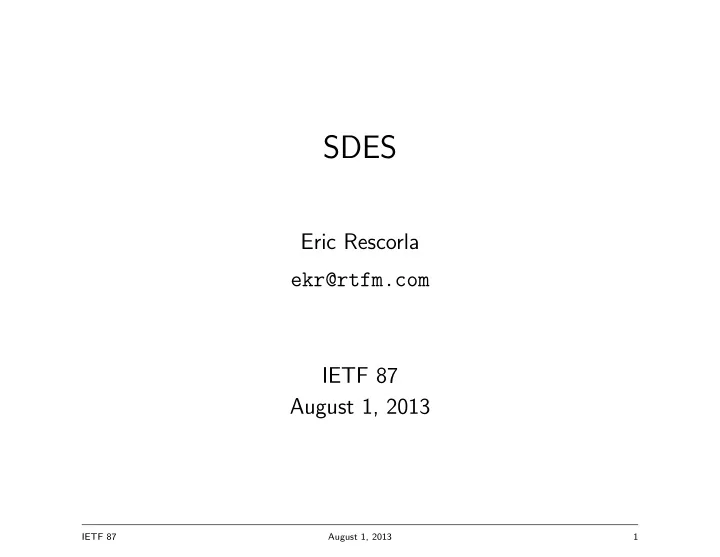

SDES Eric Rescorla ekr@rtfm.com IETF 87 August 1, 2013 IETF 87 August 1, 2013 1
Overview • Comparison of security properties • DTLS and backward compatibility • The bigger picture IETF 87 August 1, 2013 2
Security Properties wrt Signaling Server • In SDES, signaling server has the key – Passive access to the encrypted media is sufficient to recover the plaintext • In DTLS-SRTP, signaling server authenticates endpoints – Can mount a MITM attack • Key continuity or Identity allow detection of attack by signaling server – As well as identifying the person on the other end – Allows after the fact auditing as well IETF 87 August 1, 2013 3
This is the kind of thing I mean IETF 87 August 1, 2013 4
Active vs. Passive Attack. Does it matter? • Timescale – Passive attack can be mounted retrospectively – ... especially if you have the ability to capture media and logs – Active attack can only be mounted in real-time • Visibility – Passive attack can be mounted invisibly – Active attack cannot be completely hidden from user ∗ ... though detection is not always easy • Malice vs. incompetence – Easy for a site to accidentally mount a passive attack via server logs, etc. – Not possible to accidentally mount an active attack IETF 87 August 1, 2013 5
DTLS vs. SDES Performance • DTLS handshake is a trivial cost compared to audio or video encoding – Which you’re doing if you’re an endpoint – See Langley’s talk from Velocity 2010 • Clipping is a non-issue – DTLS can be done in 1RTT with False Start ∗ ... small compared to ICE overhead – Expect new work in TLS-WG on reducing DTLS latency further for subsequent calls IETF 87 August 1, 2013 6
DTLS and Backward Compatibility • The vast majority of RTP traffic isn’t SRTP • The vast majority of SRTP traffic is secured with SDES – The majority of legacy SRTP implementations only support SDES • DTLS-SRTP and SDES-SRTP interop requires gatewaying IETF 87 August 1, 2013 7
Is reencryption that big a deal? • Quite likely we’ll need media gateways anyway – Many implementations won’t do ICE – May need to transcode audio (Opus) or video (VP8) • Reencryption isn’t that expensive (see above) • Many MCUs are going to want to decrypt and reencrypt the media anyway • We still have EKT if we need it IETF 87 August 1, 2013 8
Basic Scenario DTLS SDES Keys Handshake SDES WebRTC GW Endpoint Endpoint SRTP SRTP reencrypt IETF 87 August 1, 2013 9
Reinvite for One-Way Media DTLS random key Handshake Re-invite with SDES WebRTC GW negotiated Endpoint Endpoint DTLS key SRTP SRTP reencrypt SRTP IETF 87 August 1, 2013 10
With EKT DTLS random key Handshake SDES WebRTC EKT re-INVITE with GW Endpoint Endpoint negotiated DTLS key SRTP SRTP P.S. This also works for videoconferencing IETF 87 August 1, 2013 11
With Two-Way Key Push DTLS SDES Handshake SDES WebRTC EKT++ GW Endpoint Endpoint SRTP SRTP IETF 87 August 1, 2013 12
Why does it matter what we allow: Incompetence • DTLS is already going to be mandatory – So why shouldn’t SDES be allowed? • Because people will use it – Even if it means overriding defaults – We know people do stupid stuff – ... and someone might tell them it’s faster/easier, etc. • And the problem is that SDES is so brittle – Do we really believe people will remember to sanitize their logs? • Let’s not give people the tools to shoot themselves in the foot IETF 87 August 1, 2013 13
Why does it matter what we allow: Malice • If we allow SDES, negotiation will be in the SDP • This allows for a trivial bid-down attack – Just pull out the fingerprint – ... or set the flag or whatever • This is what you do if you want to enable monitoring • Not possible to distinguish from – Laziness – People who want to be faster – Other client doesn’t support DTLS • Isolated streams + DTLS-only protect against this IETF 87 August 1, 2013 14
They say nobody will notice if you change the JS... IETF 87 August 1, 2013 15
Large scale monitoring • Say you want to monitor a lot of people – First build a massive recording system... IETF 87 August 1, 2013 16
Large Scale Monitoring of WebRTC • SDES – Get a feed of keys from signaling server – Use existing traffic capture systems to record SRTP • DTLS-SRTP – Reroute all traffic to your proxy – MITM every connection you want to monitor – This is not that easy to do – ... and not at all easy to hide • One of these things is not like the other IETF 87 August 1, 2013 17
Surely that would never happen... IETF 87 August 1, 2013 18
Summary • DTLS security properties range from somewhat better to much better – Doesn’t make the logs a huge security risk – Possible to detect attacks even without identity – With identity/isolated streams, provides good security against the site – Much more resistant to large-scale monitoring • Some legacy settings where SDES makes stuff easier – But not that much easier – And the advantage is shrinking not growing • If we allow SDES some people will use it routinely IETF 87 August 1, 2013 19
– And screw it up – Hard to distinguish malice from simple laziness • Better to just have a single secure method • Proposed Resolution: Browser-based WebRTC implementations MUST NOT implement SDES IETF 87 August 1, 2013 20
Questions? IETF 87 August 1, 2013 21
Recommend
More recommend